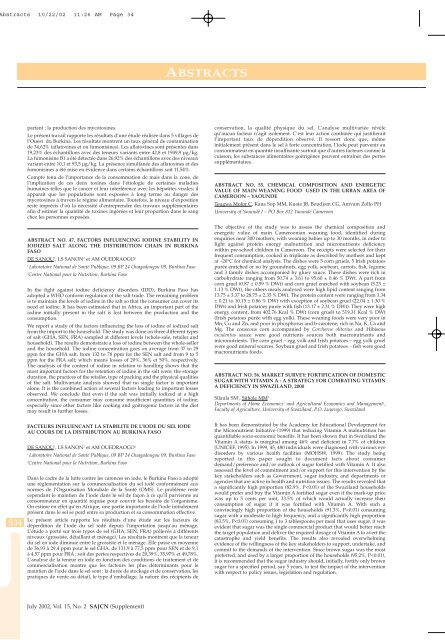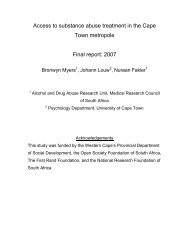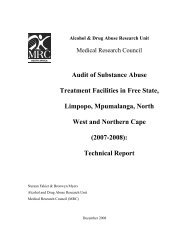Pan-African Conference 21 - 24 July 2002 Inter-Continental Hotel ...
Pan-African Conference 21 - 24 July 2002 Inter-Continental Hotel ...
Pan-African Conference 21 - 24 July 2002 Inter-Continental Hotel ...
You also want an ePaper? Increase the reach of your titles
YUMPU automatically turns print PDFs into web optimized ePapers that Google loves.
Abstracts 10/22/02 11:26 AM Page 34<br />
S34<br />
partant ; la production des mycotoxines.<br />
Le présent travail rapporte les résultats d’une étude réalisée dans 5 villages de<br />
l’Ouest du Burkina. Les résultats montrent un taux général de contamination<br />
de 34,62% (aflatoxines et ou fumonisines). Les aflatoxines sont présentes dans<br />
19,23% des échantillons avec des teneurs variants entre 42,8 et 1949,9 µg/kg.<br />
La fumonisine B1 a été détectée dans 26,92% des échantillons avec des niveaux<br />
variant entre 10,1 et 93,5 µg/kg. La présence simultanée des aflatoxines et des<br />
fumonisines a été mise en évidence dans certains échantillons soit 11,54%.<br />
Compte tenu de l’importance de la consommation de mais dans la zone, de<br />
l’implication de ces deux toxines dans l’étiologie de certaines maladies<br />
humaines telles que le cancer et leur interférence avec les hépatites virales; il<br />
apparaît que les populations sont exposées à long terme au danger des<br />
mycotoxines à travers le régime alimentaire. Toutefois, le niveau d’exposition<br />
reste imprécis d’où la nécessité d’entreprendre des travaux supplémentaires<br />
afin d’estimer la quantité de toxines ingérées et leur proportion dans le sang<br />
chez les personnes exposées.<br />
ABSTRACT NO. 47. FACTORS INFLUENCING IODINE STABILITY IN<br />
IODIZED SALT ALONG THE DISTRIBUTION CHAIN IN BURKINA<br />
FASO<br />
DE SANOU1 , LS SANON2 et AM OUEDRAOGO1 1 Laboratoire National de Santé Publique, 09 BP <strong>24</strong> Ouagadougou 09, Burkina Faso<br />
2 Centre National pour la Nutrition, Burkina Faso<br />
In the fight against iodine deficiency disorders (IDD), Burkina Faso has<br />
adopted a WHO conform regulation of the salt trade. The remaining problem<br />
is to maintain the levels of iodine in the salt so that the consumer can cover its<br />
need of iodine. It has been estimated that in Africa, an important part of the<br />
iodine initially present in the salt is lost between the production and the<br />
consumption.<br />
We report a study of the factors influencing the loss of iodine of iodized salt<br />
from the import to the household. The study was done on three different types<br />
of salt (GHA, SEN, FRA) sampled at different levels (whole-sale, retailer and<br />
household). The results demonstrate a loss of iodine between the whole-seller<br />
and the household. The iodine concentration goes on average from 37 to 29<br />
ppm for the GHA salt, from 132 to 78 ppm for the SEN salt and from 9 to 5<br />
ppm for the FRA salt; which means losses of 20%, 36% et 50%, respectively.<br />
The analysis of the content of iodine in relation to handling shows that the<br />
most important factors for the retention of iodine in the salt were: the storage<br />
duration, the practices of the retailer, type of packing and the physical qualities<br />
of the salt. Multivariate analysis showed that no single factor is important<br />
alone. It is the combined action of several factors leading to important losses<br />
observed. We conclude that even if the salt was initially iodized at a high<br />
concentration, the consumer may consume insufficient quantities of iodine;<br />
especially since other factors like cooking and goitrogenic factors in the diet<br />
may result in further losses.<br />
FACTEURS INFLUENCANT LA STABILITE DE L’IODE DU SEL IODE<br />
AU COURS DE LA DISTRIBUTION AU BURKINA FASO<br />
DE SANOU 1 , LS SANON 2 et AM OUEDRAOGO 1<br />
1 Laboratoire National de Santé Publique, 09 BP <strong>24</strong> Ouagadougou 09, Burkina Faso<br />
2 Centre National pour la Nutrition, Burkina Faso<br />
Dans le cadre de la lutte contre les carences en iode, le Burkina Faso a adopté<br />
une réglementation sur la commercialisation du sel iodé conformément aux<br />
normes de l’Organisation Mondiale de la Santé (OMS). Le problème reste<br />
cependant le maintien de l’iode dans le sel de façon à ce qu’il parvienne au<br />
consommateur en quantité requise pour couvrir les besoins de l’organisme.<br />
On estime en effet qu’en Afrique, une partie importante de l’iode initialement<br />
présent dans le sel se perd entre sa production et sa consommation effective.<br />
Le présent article rapporte les résultats d’une étude sur les facteurs de<br />
déperdition de l’iode du sel iodé depuis l’importation jusqu’au ménage.<br />
L’étude a porté sur trois types de sel (GHA, SEN, FRA) prélevés à différents<br />
niveaux (grossiste, détaillant et ménage). Les résultats montrent que la teneur<br />
du sel en iode diminue entre le grossiste et le ménage. Elle passe en moyenne<br />
de 36,93 à 29,4 ppm pour le sel GHA, de 131,9 à 77,5 ppm pour SEN et de 9,1<br />
à 4,57 ppm pour FRA ; soit des pertes respectives de 20,39%, 35,97% et 49,78%.<br />
L’analyse de la teneur en iode en fonction des conditions de traitement et de<br />
commercialisation montre que les facteurs les plus déterminants pour le<br />
maintien de l’iode dans le sel sont : la durée de stockage et de conservation, les<br />
pratiques de vente au détail, le type d’emballage, la nature des récipients de<br />
<strong>July</strong> <strong>2002</strong>, Vol. 15, No. 2 SAJCN (Supplement)<br />
ABSTRACTS<br />
conservation, la qualité physique du sel. L’analyse multivariée révèle<br />
qu’aucun facteur n’agit isolement. C’est leur action combinée qui justifierait<br />
l’important taux de déperdition observé. Il ressort donc que, même<br />
initialement présent dans le sel à forte concentration, l’iode peut parvenir au<br />
consommateur en quantité insuffisante surtout que d’autres facteurs comme la<br />
cuisson, les substances alimentaires goitrigènes peuvent entraîner des pertes<br />
supplémentaires.<br />
ABSTRACT NO. 55. CHEMICAL COMPOSITION AND ENERGETIC<br />
VALUE OF MAIN WEANING FOOD USED IN THE URBAN AREA OF<br />
CAMEROON – YAOUNDE<br />
Teugwa Mofor C, Kana Sop MM, Kuate JB, Boudjom CG, Amvam Zollo PH<br />
University of Yaoundé I – PO Box 812 Yaoundé Cameroon<br />
The objective of the study was to assess the chemical composition and<br />
energetic value of main Cameroonian weaning food, identified during<br />
enquiries near 300 mothers, with weaning babies up to 30 months, in order to<br />
fight against protein energy malnutrition and micronutrients deficiency<br />
within pre-school children in Cameroon. The receipts were selected for their<br />
frequent consumption, cooked in triplicate as described by mothers and kept<br />
at –20°C for chemical analysis. The dishes were 5 corn gruels, 5 Irish potatoes<br />
purée enriched or no by groundnuts, egg yolk, soybean, carrots, fish, legume<br />
and 3 family dishes accompanied by gluey sauce. These dishes were rich in<br />
carbohydrate ranging from 50.74 ± 3.61 to 95.60 ± 0.46 % DWt. A part from<br />
corn gruel (0.87 ± 0.59 % DWt) and corn gruel enriched with soybean (5.25 ±<br />
1.13 % DWt), the others meals analysed were high lipid content ranging from<br />
13.75 ± 3.37 to 28.75 ± 2.35 % DWt. The protein content were ranging from 3.34<br />
± 0.<strong>21</strong> to 10.15 ± 0.86 % DWt with exception of soybean gruel (22.04 ± 1.30 %<br />
DWt) and Irish potatoes purée with fish (13.17 ± 2.31 % DWt). They were high<br />
energy content, from 402.76 Kcal % DWt (corn gruel) to 519.31 Kcal % DWt<br />
(Irish potatoes purée with egg yolk). These weaning foods were very poor in<br />
Mn, Cu and Zn, and poor in phosphorus and b-carotene; rich in Na, K, Ca and<br />
Mg. The couscous corn accompanied by Corchorus olitorius and Hibiscus<br />
esculentus sauce were good nutrients sources both macronutrients and<br />
micronutrients. The corn gruel – egg yolk and Irish potatoes – egg yolk gruel<br />
were good mineral sources. Soybean gruel and Irish potatoes - fish were good<br />
macronutrients foods.<br />
ABSTRACT NO. 56. MARKET SURVEY: FORTIFICATION OF DOMESTIC<br />
SUGAR WITH VITAMIN A - A STRATEGY FOR COMBATING VITAMIN<br />
A DEFICIENCY IN SWAZILAND, 2000<br />
Silaula SM 1 , Sithole MM 2<br />
Departments of Home Economics 1 and Agricultural Economics and Management 2 ,<br />
Faculty of Agriculture, University of Swaziland, P.O. Luyengo, Swaziland<br />
It has been demonstrated by the Academy for Educational Development for<br />
the Micronutrient Initiative (1999) that reducing Vitamin A malnutrition has<br />
quantifiable socio-economic benefits. It has been shown that in Swaziland the<br />
Vitamin A status is marginal among 46% and deficient in 7.7% of children<br />
(UNICEF, 1995). In 1999, 45, 480 individuals were diagnosed with various eye<br />
disorders by various health facilities (MOHSW, 1999). The study being<br />
reported in this paper sought to document facts about consumer<br />
demand/preference and/or outlook of sugar fortified with Vitamin A. It also<br />
assessed the level of commitment and/or support for this intervention by the<br />
key stakeholders such as Government, sugar industry, and departments or<br />
agencies that are active in health and nutrition issues. The results revealed that<br />
a significantly high proportion (82.9%, P

















